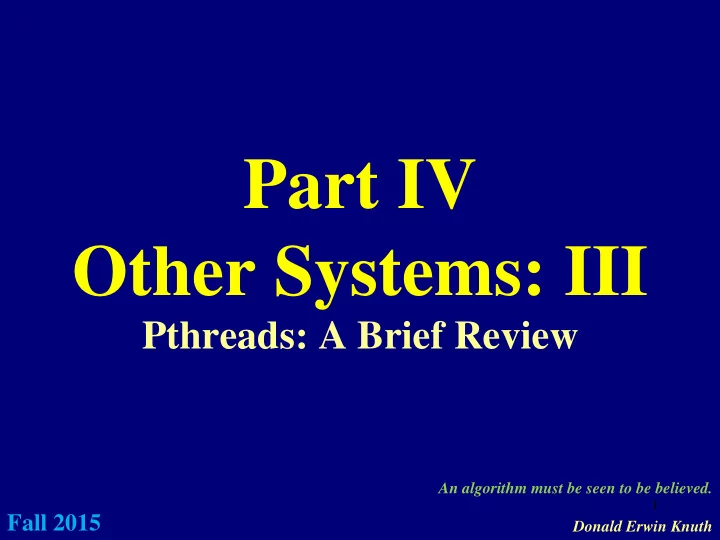

Part IV Other Systems: III Pthreads: A Brief Review An algorithm must be seen to be believed. 1 Fall 2015 Donald Erwin Knuth
Th The PO e POSI SIX Sta X Stand ndar ard: d: 1/ 1/2 POSIX ( P ortable O perating S ystem I nterfaces) is a family of standards for maintaining compatibility between operating systems. POSIX is a Unix-like operating system environment and is currently available on Unix/Linux, Windows, OS/2 and DOS. 2
Th The PO e POSI SIX Sta X Stand ndar ard: d: 2/ 2/2 Pthreads (POSIX Threads) is a POSIX standard for threads. The standard, POSIX.1c thread extension, defines thread creation and manipulation. This standard defines thread management, mutexes, conditions, read/write locks, barriers, etc. Except for the monitors, all features are available in Pthreads. 3
Threa Th ead d Cr Crea eation on Always includes the pthread.h header file. int pthread_create( pthread_t *tid, const pthread_attr_t *attr, void *(*start)(void *), void *arg); pthread_create() creates a thread and runs function start() with argument list arg . attr specifies optional creation attributes. The ID of the newly created thread is returned with tid . Non-zero return value means creation failure. 4
Threa Th ead d Jo Join Use pthread_join() to join with a thread. The following waits for thread to complete, and returns thread ’s exit value if value_ptr is not NULL . Use NULL if you don’t use exit value. Join failed if pthread_join() returns a non- zero value. int pthread_join( pthread_t thread, void **value_ptr); 5
Threa Th ead d Ex Exit Use pthread_exit() to terminate a thread and return the value value_ptr to any joining thread. Exit failed if pthread_exit() returns a non- zero value. Use NULL for value_ptr if you don’t use exit value. int pthread_exit( pthread_t thread, void *value_ptr); 6
Mu Mutex ex: 1/ 1/2 A mutex has a type pthread_mutex_t . Mutexes initially are unlocked. Only the owner can unlock a mutex. Since mutexes cannot be copied, use pointers. Use pthread_mutex_destroy() to destroy a mutex. Make sure no thread is blocked inside. pthread_mutex_t mutex = PTHREAD_MUTEX_INITIALIZER; int pthread_mutex_init( pthread_mutex_t *mutex, pthread_mutexattr_t *attr); int pthread_mutex_destroy( 7 pthread_mutex_t *mutex);
Mu Mutex ex: 2/ 2/2 If pthread_mutex_trylock() returns EBUSY , the lock is already locked. Otherwise, the calling thread becomes the owner of this lock. With pthread_mutexattr_settype() , the type of a mutex can be set to allow recursive locking or report deadlock if the owner locks again. int pthread_mutex_lock( pthread_mutex_t *mutex); int pthread_mutex_unlock( pthread_mutex_t *mutex); int pthread_mutex_trylock( pthread_mutex_t *mutex); 8
Co Cond ndition on Va Variab ables es: 1/ 1/2 Conditions in Pthreads are usually used with a mutex to enforce mutual exclusion. pthread_cond_t cond = PTHREAD_COND_INITIALIZER; int pthread_cond_init( pthread_cond_t *cond, const pthread_condattr_t *attr); int pthread_cond_destroy( pthread_cond_t *cond); int pthread_cond_wait( pthread_cond_t *cond, pthread_mutex_t *mutex); int pthread_cond_signal( pthread_cond_t *cond); int pthread_cond_broadcast( 9 pthread_cond_t *cond);
Co Cond ndition on Va Variab ables es: 2/ 2/2 pthread_cond_wait() and pthread_cond_signal() are the wait() and signal() methods in Thr hrea eadM dMen ento tor , and are wait() and notify() in Java. pthread_cond_signal() uses Mesa type and the released thread must recheck the condition. int pthread_cond_wait( pthread_cond_t *cond, pthread_mutex_t *mutex); int pthread_cond_signal( pthread_cond_t *cond); int pthread_cond_broadcast( pthread_cond_t *cond); 10
Si Simul ulat atin ing g a a Me Mesa sa Mo Moni nitor or: 1/ 1/2 Use a mutex for protecting the monitor. Lock and unlock this mutex upon entering and exiting the monitor. When a thread calls a condition wait, it relinquishes the monitor mutex. Once blocked, the monitor mutex becomes available to other threads. The released thread (from a condition wait) becomes the new owner of the monitor mutex. 11
Si Simul ulat atin ing g a a Me Mesa sa Mo Moni nitor or: 2/ 2/2 pthread_mutex_t MonitorLock = PTHREAD_MUTEX_INITIALIZER; Pthread_cond_t cond = PTHREAD_COND_INITIALIZER; monitor procedure pthread_mutex_lock(&MonitorLock); // enter the monitor // other statements whi hile le ( condition is not met ) // this is a Mesa type pthread_cond_wait(&cond, &MonitorLock); // other statements pthread_mutex_unlock(&MonitorLock); // exit monitor monitor procedure pthread_mutex_lock(&MonitorLock); // enter the monitor // other statements // cause condition to happen pthread_cond_signal(&cond); // other statements pthread_mutex_unlock(&MonitorLock); // exit monitor 12
Si Simul ulat atin ing g a a Ho Hoar are Mo e Moni nitor or Simulating a Hoare type monitor requires the use of general semaphores. The Pthreads standard does not have semaphores. Instead, POSIX.1b standard has the Unix semaphores. With POSIX.1b semaphores, it is easy to simulate a Hoare type monitor. Many OS textbooks discuss such a simulation. Also see our reading lists for such a solution. 13
Languages vs. Languages vs. Libraries: Libraries: 1/2 1/2 Libraries are extension to a sequential language. Programmers may try various approaches that fit his/her needs. Programs can be deployed without requiring any changes in the tools (e.g., compiler). Libraries may not be well-defined and completely portable. Some features may be difficult to define and/or implement (e.g., Hoare type monitors). Programs may be difficult to understand because API function calls can scatter everywhere and sometimes cryptic. 14
Languages vs. Languages vs. Libraries: Libraries: 2/2 2/2 With the language-based approach, the intent of the programmer is easier to express and understand, both by other programmers and by program analysis tools. Languages usually require the standardization of new constructs and perhaps new keywords. Language features are fixed. Each language may only support one or a few concurrent programming models, and may not be very flexible. 15
The End 16
Recommend
More recommend